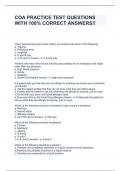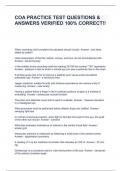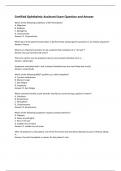COA Study guides, Class notes & Summaries
Looking for the best study guides, study notes and summaries about COA? On this page you'll find 404 study documents about COA.
Page 3 out of 404 results
Sort by
COA PRACTICE TEST QUESTIONS WITH 100% CORRECT ANSWERS!!
COA PRACTICE TEST QUESTIONS & ANSWERS VERIFIED 100% CORRECT!!
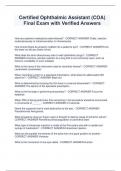
-
Certified Ophthalmic Assistant (COA) Final Exam with Verified Answers
- Exam (elaborations) • 71 pages • 2024
-
- $7.99
- + learn more
ow are systemic medications administered? - CORRECT ANSWER-Orally, injection (subcutaneously or intramuscularly) or intravenously How should drops be properly instilled into a patient's eye? - CORRECT ANSWER-Into the lower cul de sac (lower fornix) What does the term idiosyncrasy refer to with ophthalmic drugs? - CORRECT ANSWER-A bizarre, peculiar reaction to a drug that is not commonly seen, such as tremors, excitability or even collapse What is the name of the instrument used to ne...
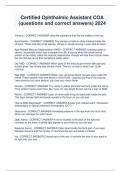
-
Certified Ophthalmic Assistant COA (questions and correct answers) 2024
- Exam (elaborations) • 11 pages • 2024
-
- $7.99
- + learn more
Vitreous - CORRECT ANSWER-Jelly-like substance that fills the middle of the eye. Eye Floaters - CORRECT ANSWER-Tiny clumps of cells or other material inside the vitreous. These look like small specks, strings or clouds moving in your field of vision. Age-Related Macular Degeneration (AMD) - CORRECT ANSWER-Leading cause of severe, irreversible vision loss in people over 60. It occurs when the small central portion of the retina, called the macula, deteriorates. People will lose their cent...
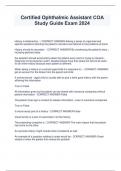
-
Certified Ophthalmic Assistant COA Study Guide Exam 2024
- Exam (elaborations) • 3 pages • 2024
-
- $7.99
- + learn more
History is obtained by : - CORRECT ANSWER-Asking a series of organized and specific questions directing the patient's narrative and tailored to the problems at hand. History should be recorded : - CORRECT ANSWER-By condensing the patient's story , including pertinent facts the assistant should avoid writing down the patient every word or trying to interpret , Diagnosis is the physician realm. Questionnaires have their place but cannot be used for an entire history because each patie...
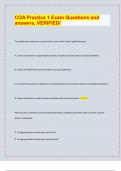
-
COA Practice 1 Exam Questions and answers, VERIFIED/| latest update 2024/25|
- Exam (elaborations) • 44 pages • 2024
-
- $10.49
- + learn more
COA Practice 1 Exam Questions and answers, VERIFIED/ The applanation tonometer is preferred in cases of low scleral rigidity because... A. it does not displace an appreciable amount of aqueous and thus does not cause distention B. it does not flatten the cornea and does not cause distention C. it is performed when the patient is in a seated position and therefore gravity can equalize distention D. topical anesthetic is used and does not distend the ocular structures - -A Which position ...
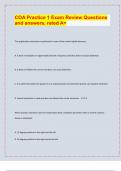
-
COA Practice 1 Exam Review Questions and answers, rated A+| latest update 2024/25|
- Exam (elaborations) • 44 pages • 2024
-
- $10.49
- + learn more
COA Practice 1 Exam Review Questions and answers, rated A+ The applanation tonometer is preferred in cases of low scleral rigidity because... A. it does not displace an appreciable amount of aqueous and thus does not cause distention B. it does not flatten the cornea and does not cause distention C. it is performed when the patient is in a seated position and therefore gravity can equalize distention D. topical anesthetic is used and does not distend the ocular structures - -A Which pos...
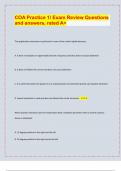
-
COA Practice 1/ Exam Review Questions and answers, rated A+| latest update 2024/25|
- Exam (elaborations) • 44 pages • 2024
-
- $10.49
- + learn more
COA Practice 1/ Exam Review Questions and answers, rated A+ The applanation tonometer is preferred in cases of low scleral rigidity because... A. it does not displace an appreciable amount of aqueous and thus does not cause distention B. it does not flatten the cornea and does not cause distention C. it is performed when the patient is in a seated position and therefore gravity can equalize distention D. topical anesthetic is used and does not distend the ocular structures - -A Which po...
Certified Ophthalmic Assistant Exam Question and Answer
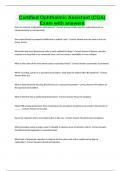
-
Certified Ophthalmic Assistant (COA) Exam with answers
- Exam (elaborations) • 105 pages • 2024
-
- $14.49
- + learn more
Certified Ophthalmic Assistant (COA) Exam with answers How are systemic medications administered? -Correct Answer-Orally, injection (subcutaneously or intramuscularly) or intravenously How should drops be properly instilled into a patient's eye? -Correct Answer-Into the lower cul de sac (lower fornix) What does the term idiosyncrasy refer to with ophthalmic drugs? -Correct Answer-A bizarre, peculiar reaction to a drug that is not commonly seen, such as tremors, excitability or even colla...

